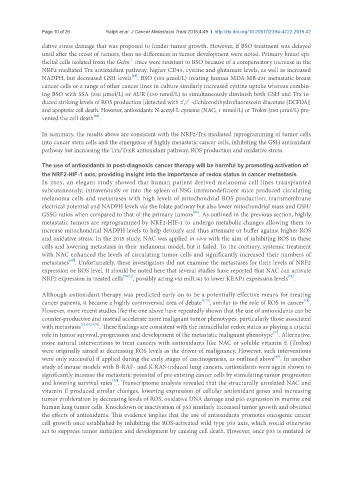Page 590 - Read Online
P. 590
Page 10 of 26 Ralph et al. J Cancer Metastasis Treat 2018;4:49 I http://dx.doi.org/10.20517/2394-4722.2018.42
dative stress damage that was proposed to hinder tumor growth. However, if BSO treatment was delayed
until after the onset of tumors, then no differences in tumor development were noted. Primary breast epi-
-/-
thelial cells isolated from the Gclm mice were resistant to BSO because of a compensatory increase in the
NRF2-mediated Trx antioxidant pathway, higher CD44, cystine and glutamate levels, as well as increased
[68]
NADPH, but decreased GSH levels . BSO (150 μmol/L) treating human MDA-MB-231 metastatic breast
cancer cells or a range of other cancer lines in culture similarly increased cystine uptake whereas combin-
ing BSO with SSA (250 μmol/L) or AUR (250 nmol/L) to simultaneously diminish both GSH and Trx in-
duced striking levels of ROS production [detected with 2’,7’ -dichlorodihydrofluorescein diacetate (DCFDA)]
and apoptotic cell death. However, antioxidants N-acetyl-L-cysteine (NAC; 1 mmol/L) or Trolox (250 μmol/L) pre-
[68]
vented the cell death .
In summary, the results above are consistent with the NRF2-Trx mediated reprogramming of tumor cells
into cancer stem cells and the emergence of highly metastatic cancer cells, inhibiting the GSH antioxidant
pathway but increasing the Trx/TrxR antioxidant pathway, ROS production and oxidative stress.
The use of antioxidants in post-diagnosis cancer therapy will be harmful by promoting activation of
the NRF2-HIF-1 axis, providing insight into the importance of redox status in cancer metastasis
In 2015, an elegant study showed that human patient derived melanoma cell lines transplanted
subcutaneously, intravenously or into the spleen of NSG immunodeficient mice produced circulating
melanoma cells and metastases with high levels of mitochondrial ROS production, transmembrane
electrical potential and NADPH levels via the folate pathway but also lower mitochondrial mass and GSH/
[69]
GSSG ratios when compared to that of the primary tumors . As outlined in the previous section, highly
metastatic tumors are reprogrammed by NRF2-HIF-1 to undergo metabolic changes allowing them to
increase mitochondrial NADPH levels to help detoxify and thus attenuate or buffer against higher ROS
and oxidative stress. In the 2015 study, NAC was applied in vivo with the aim of inhibiting ROS in these
cells and lowering metastasis in their melanoma model, but it failed. To the contrary, systemic treatment
with NAC enhanced the levels of circulating tumor cells and significantly increased their numbers of
[69]
metastases . Unfortunately, these investigators did not examine the metastases for their levels of NRF2
expression or ROS level. It should be noted here that several studies have reported that NAC can activate
[72]
NRF2 expression in treated cells [70,71] , possibly acting via miR141 to lower KEAP1 expression levels .
Although antioxidant therapy was predicted early on to be a potentially effective means for treating
[74]
cancer patients, it became a highly controversial area of debate [3,73] , similar to the role of ROS in cancer .
However, more recent studies like the one above have repeatedly shown that the use of antioxidants can be
counter-productive and instead accelerate more malignant tumor phenotypes, particularly those associated
with metastasis [52,69,75,76] . These findings are consistent with the intracellular redox status as playing a crucial
[77]
role in tumor survival, progression and development of the metastatic malignant phenotype . Alternative,
more natural interventions to treat cancers with antioxidants like NAC or soluble vitamin E (Trolox)
were originally aimed at decreasing ROS levels as the driver of malignancy. However, such interventions
[68]
were only successful if applied during the early stages of carcinogenesis, as outlined above . In another
study of mouse models with B-RAF- and K-RAS-induced lung cancers, antioxidants were again shown to
significantly increase the metastatic potential of pre-existing cancer cells by stimulating tumor progression
[78]
and lowering survival rates . Transcriptome analysis revealed that the structurally unrelated NAC and
vitamin E produced similar changes, lowering expression of cellular antioxidant genes and increasing
tumor proliferation by decreasing levels of ROS, oxidative DNA damage and p53 expression in murine and
human lung tumor cells. Knockdown or inactivation of p53 similarly increased tumor growth and obviated
the effects of antioxidants. This evidence implies that the use of antioxidants promotes oncogenic cancer
cell growth once established by inhibiting the ROS-activated wild type p53 axis, which would otherwise
act to suppress tumor initiation and development by causing cell death. However, once p53 is mutated or

